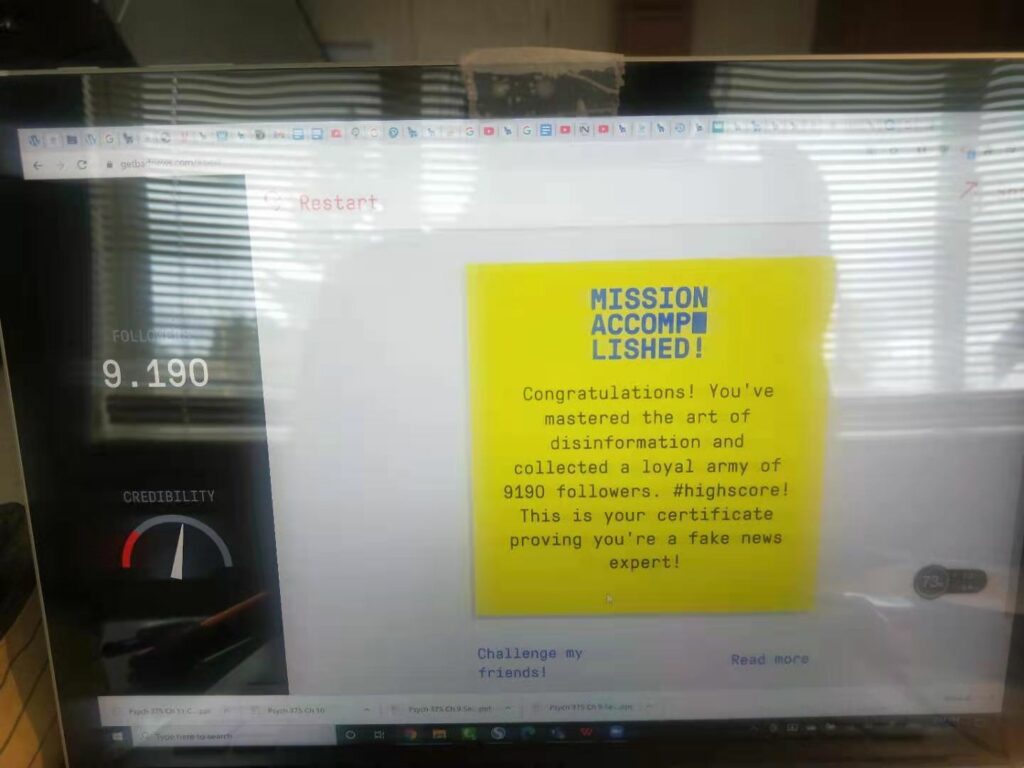
The Bad News game was super interesting to lead the audience to an active learning pathway. The audience can choose whatever road or stream that they want to go and will create different themes depending on what we choose. The one thing I like about it, the game did a really good job on the Spatial Contiguity principle because they always try to put pictures and words together. So, we can have a better understanding of the story that we are making. The other thing was the game gives the audience direct feedback to let them know what we are doing so far and how to improve it. It gives us guidance to gain more followers. One thing I think this needs to improve by adding a human voice or having a button to read aloud or read the comment out could be more fun.
My sketch note-taking is based on my psychology course this semester. I am trying to create the original text and content to a new form of text like using pictures instead of boring explanations and making a case study to a visual image. This way can help me apply to the Redundancy principle instead of distracting by long paragraph. I was taking all the keywords and put them into my way of memorizing them. My note is like a retrieval cue like once I saw the picture, I will know what is talking about in the lecture. I also used the Signal principle that highlights some keywords to help me remember. Symbols and pictures will create a more interesting context for reviewing and a new way to apply old knowledge.
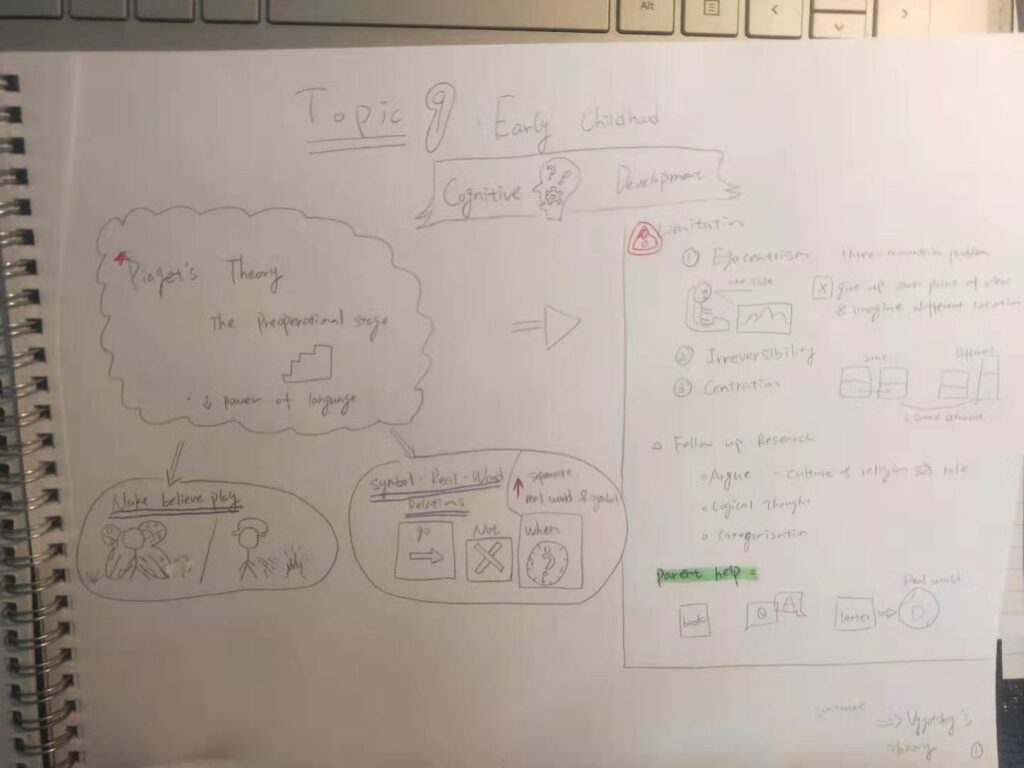

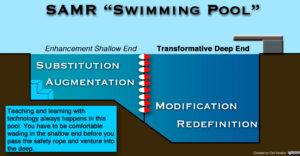 Multimedia is widely using in people’s daily life, so people are more likely to seek fast and easy technologies such as video, PowerPoint, WordPress, or some other online teaching tools. After I learned the SAMR model, I found that some of the paperwork in school can not just substitute for technologies. For example, I know a lot of teachers are using software or apps to create a test. It saves a lot of time because the computer is doing all the calculations for us. However, if there is one small error that carries out through the whole exam students will be more likely to get a zero. One small error can make a huge difference so the combined real person to go through it or repeat the process might be better just change to technologies. Another point is teachers need to pay more attention to the surface “substitution” part. If students can not get full engagement on the base level, then it is hard to dive into redefinition by using different technology tools.
Multimedia is widely using in people’s daily life, so people are more likely to seek fast and easy technologies such as video, PowerPoint, WordPress, or some other online teaching tools. After I learned the SAMR model, I found that some of the paperwork in school can not just substitute for technologies. For example, I know a lot of teachers are using software or apps to create a test. It saves a lot of time because the computer is doing all the calculations for us. However, if there is one small error that carries out through the whole exam students will be more likely to get a zero. One small error can make a huge difference so the combined real person to go through it or repeat the process might be better just change to technologies. Another point is teachers need to pay more attention to the surface “substitution” part. If students can not get full engagement on the base level, then it is hard to dive into redefinition by using different technology tools.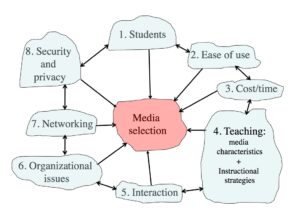 Technologies give people more variety of learning methods. The strength of the SECTION model does explain how people can use select teaching and media tools base on students’ interests. For example, technologies can well support people who are blind or hearing disorder; then they can use either voice record method through online teaching. It is a better way to lower the cost of hiring a professional teacher and decrease stress when people are struggling to learn in a crowded environment. However, depends on the lesson or app that people are creating, it may increase the cost by time and retesting the lessons. Besides, because of the modern fast development of multimedia, it is a lack of privacy that teachers can control. Overall, teachers need to think it is necessary to use section model and multimedia or not, then create the lesson based on the needs.
Technologies give people more variety of learning methods. The strength of the SECTION model does explain how people can use select teaching and media tools base on students’ interests. For example, technologies can well support people who are blind or hearing disorder; then they can use either voice record method through online teaching. It is a better way to lower the cost of hiring a professional teacher and decrease stress when people are struggling to learn in a crowded environment. However, depends on the lesson or app that people are creating, it may increase the cost by time and retesting the lessons. Besides, because of the modern fast development of multimedia, it is a lack of privacy that teachers can control. Overall, teachers need to think it is necessary to use section model and multimedia or not, then create the lesson based on the needs.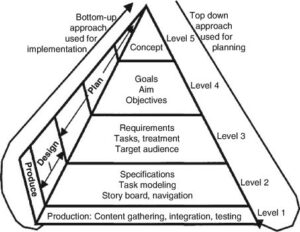 ns. Nowadays, there are many multimedia lessons had well developed, so people should first make the lesson as fun as possible to catch the audience’s eyes without drying them out through the lesson. Brainstorm and detail plans will make teachers less frustrating if students lose interest or too difficult to follow. The teacher may easily change to another way of teaching this concept because they had fully prepared those outcomes. When people making plans, they should know how to interact with their audience that is related to the Ecological theory. This theory demonstrates how child development can interact with the environment and how environmental factors will influence children’s behavior (Paquette&Ryan, 2009). Therefore, if the teacher had made enough interactions with students, they will not only learn some knowledge through this lesson but also use this knowledge to apply future problems.
ns. Nowadays, there are many multimedia lessons had well developed, so people should first make the lesson as fun as possible to catch the audience’s eyes without drying them out through the lesson. Brainstorm and detail plans will make teachers less frustrating if students lose interest or too difficult to follow. The teacher may easily change to another way of teaching this concept because they had fully prepared those outcomes. When people making plans, they should know how to interact with their audience that is related to the Ecological theory. This theory demonstrates how child development can interact with the environment and how environmental factors will influence children’s behavior (Paquette&Ryan, 2009). Therefore, if the teacher had made enough interactions with students, they will not only learn some knowledge through this lesson but also use this knowledge to apply future problems.

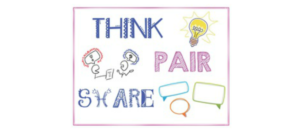
Recent Comments